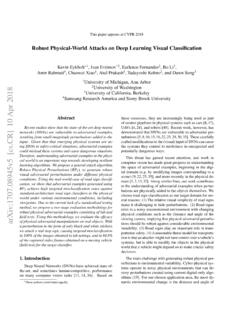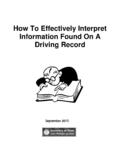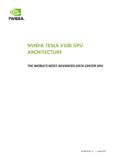Transcription of End to End Learning for Self-Driving Cars - arXiv
1 End to End Learning for Self-Driving CarsMariusz BojarskiNVIDIA CorporationHolmdel, NJ 07735 Davide Del TestaNVIDIA CorporationHolmdel, NJ 07735 Daniel DworakowskiNVIDIA CorporationHolmdel, NJ 07735 Bernhard FirnerNVIDIA CorporationHolmdel, NJ 07735 Beat FleppNVIDIA CorporationHolmdel, NJ 07735 Prasoon GoyalNVIDIA CorporationHolmdel, NJ 07735 Lawrence D. JackelNVIDIA CorporationHolmdel, NJ 07735 Mathew MonfortNVIDIA CorporationHolmdel, NJ 07735 Urs MullerNVIDIA CorporationHolmdel, NJ 07735 Jiakai ZhangNVIDIA CorporationHolmdel, NJ 07735 Xin ZhangNVIDIA CorporationHolmdel, NJ 07735 Jake ZhaoNVIDIA CorporationHolmdel, NJ 07735 Karol ZiebaNVIDIA CorporationHolmdel, NJ 07735 AbstractWe trained a convolutional neural network (CNN) to map raw pixels from a sin-gle front-facing camera directly to steering commands.
2 This end-to-end approachproved surprisingly powerful. With minimum training data from humans the sys-tem learns to drive in traffic on local roads with or without lane markings and onhighways. It also operates in areas with unclear visual guidance such as in parkinglots and on unpaved system automatically learns internal representations of the necessary process-ing steps such as detecting useful road features with only the human steering angleas the training signal. We never explicitly trained it to detect, for example, the out-line of to explicit decomposition of the problem, such as lane marking detec-tion, path planning, and control, our end-to-end system optimizes all processingsteps simultaneously. We argue that this will eventually lead to better perfor-mance and smaller systems.
3 Better performance will result because the internalcomponents self -optimize to maximize overall system performance, instead of op-timizing human-selected intermediate criteria, e. g., lane detection. Such criteriaunderstandably are selected for ease of human interpretation which doesn t auto-matically guarantee maximum system performance. Smaller networks are possi-ble because the system learns to solve the problem with the minimal number ofprocessing used an NVIDIA DevBox and Torch 7 for training and an NVIDIADRIVETMPX Self-Driving car computer also running Torch 7 for determiningwhere to drive. The system operates at 30 frames per second (FPS).1 [ ] 25 Apr 20161 IntroductionCNNs [1] have revolutionized pattern recognition [2]. Prior to the widespread adoption of CNNs,most pattern recognition tasks were performed using an initial stage of hand-crafted feature extrac-tion followed by a classifier.
4 The breakthrough of CNNs is that features are learned automaticallyfrom training examples. The CNN approach is especially powerful in image recognition tasks be-cause the convolution operation captures the 2D nature of images. Also, by using the convolutionkernels to scan an entire image, relatively few parameters need to be learned compared to the totalnumber of CNNs with learned features have been in commercial use for over twenty years [3], theiradoption has exploded in the last few years because of two recent developments. First, large, labeleddata sets such as the Large Scale Visual Recognition Challenge (ILSVRC) [4] have become avail-able for training and validation. Second, CNN Learning algorithms have been implemented on themassively parallel graphics processing units (GPUs) which tremendously accelerate Learning this paper, we describe a CNN that goes beyond pattern recognition.
5 It learns the entire pro-cessing pipeline needed to steer an automobile. The groundwork for this project was done over 10years ago in a Defense Advanced Research Projects Agency (DARPA) seedling project known asDARPA Autonomous Vehicle (DAVE) [5] in which a sub-scale radio control (RC) car drove througha junk-filled alley way. DAVE was trained on hours of human driving in similar, but not identical en-vironments. The training data included video from two cameras coupled with left and right steeringcommands from a human many ways, DAVE-2 was inspired by the pioneering work of Pomerleau [6] who in 1989 built theAutonomous Land Vehicle in a Neural Network (ALVINN) system. It demonstrated that an end-to-end trained neural network can indeed steer a car on public roads. Our work differs in that 25 years ofadvances let us apply far more data and computational power to the task.
6 In addition, our experiencewith CNNs lets us make use of this powerful technology. (ALVINN used a fully-connected networkwhich is tiny by today s standard.)While DAVE demonstrated the potential of end-to-end Learning , and indeed was used to justifystarting the DARPA Learning Applied to Ground Robots (LAGR) program [7], DAVE s performancewas not sufficiently reliable to provide a full alternative to more modular approaches to off-roaddriving. DAVE s mean distance between crashes was about 20 meters in complex months ago, a new effort was started at NVIDIA that sought to build on DAVE and create arobust system for driving on public roads. The primary motivation for this work is to avoid the needto recognize specific human-designated features, such as lane markings, guard rails, or other cars ,and to avoid having to create a collection of if, then, else rules, based on observation of thesefeatures.
7 This paper describes preliminary results of this new Overview of the DAVE-2 SystemFigure 1 shows a simplified block diagram of the collection system for training data for cameras are mounted behind the windshield of the data-acquisition car. Time-stamped videofrom the cameras is captured simultaneously with the steering angle applied by the human steering command is obtained by tapping into the vehicle s Controller Area Network (CAN)bus. In order to make our system independent of the car geometry, we represent the steering com-mand as1/rwhereris the turning radius in meters. We use1/rinstead ofrto prevent a singularitywhen driving straight (the turning radius for driving straight is infinity).1/rsmoothly transitionsthrough zero from left turns (negative values) to right turns (positive values).
8 Training data contains single images sampled from the video, paired with the corresponding steeringcommand (1/r). Training with data from only the human driver is not sufficient. The network mustlearn how to recover from mistakes. Otherwise the car will slowly drift off the road. The trainingdata is therefore augmented with additional images that show the car in different shifts from thecenter of the lane and rotations from the direction of the cameraCenter cameraRight cameraSteering wheel angle(via CAN bus)External solid-state drive for data storageNVIDIA DRIVETM PXFigure 1: High-level view of the data collection for two specific off-center shifts can be obtained from the left and the right camera. Ad-ditional shifts between the cameras and all rotations are simulated by viewpoint transformation ofthe image from the nearest camera.
9 Precise viewpoint transformation requires 3D scene knowledgewhich we don t have. We therefore approximate the transformation by assuming all points belowthe horizon are on flat ground and all points above the horizon are infinitely far away. This worksfine for flat terrain but it introduces distortions for objects that stick above the ground, such as cars ,poles, trees, and buildings. Fortunately these distortions don t pose a big problem for network train-ing. The steering label for transformed images is adjusted to one that would steer the vehicle backto the desired location and orientation in two block diagram of our training system is shown in Figure 2. Images are fed into a CNN whichthen computes a proposed steering command. The proposed command is compared to the desiredcommand for that image and the weights of the CNN are adjusted to bring the CNN output closer tothe desired output.
10 The weight adjustment is accomplished using back propagation as implementedin the Torch 7 machine Learning cameraCenter cameraRight cameraRandom shift and rotationAdjust for shift and rotationCNN-Back propagationweight adjustmentRecorded steering wheel angleNetwork computed steering commandDesired steering commandErrorFigure 2: Training the neural trained, the network can generate steering from the video images of a single center configuration is shown in Figure cameraCNNN etwork computed steering commandDrive by wire interfaceFigure 3: The trained network is used to generate steering commands from a single front-facingcenter Data CollectionTraining data was collected by driving on a wide variety of roads and in a diverse set of lightingand weather conditions.


![arXiv:0706.3639v1 [cs.AI] 25 Jun 2007](/cache/preview/4/1/3/9/3/1/4/b/thumb-4139314b93ef86b7b4c2d05ebcc88e46.jpg)

![arXiv:1301.3781v3 [cs.CL] 7 Sep 2013](/cache/preview/4/d/5/0/4/3/4/0/thumb-4d504340120163c0bdf3f4678d8d217f.jpg)
![@google.com arXiv:1609.03499v2 [cs.SD] 19 Sep 2016](/cache/preview/c/3/4/9/4/6/9/b/thumb-c349469b499107d21e221f2ac908f8b2.jpg)






